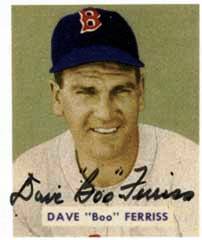May 13, 1945: Boo Ferriss’s scoreless inning streak ends, but he still wins third straight
 Dave “Boo” Ferriss, an ex-GI discharged from the Army Air Corps in February 1945, began his major-league career with an astonishing eight consecutive wins in 1945. The start of his career was as unlikely as that of any player before him, since Ferriss had minimal time as a professional player prior to his debut. In his first two starts for the Boston Red Sox, Ferriss hurled shutouts against the Philadelphia A’s and New York Yankees. The American League was starting to take notice of the newcomer.
Dave “Boo” Ferriss, an ex-GI discharged from the Army Air Corps in February 1945, began his major-league career with an astonishing eight consecutive wins in 1945. The start of his career was as unlikely as that of any player before him, since Ferriss had minimal time as a professional player prior to his debut. In his first two starts for the Boston Red Sox, Ferriss hurled shutouts against the Philadelphia A’s and New York Yankees. The American League was starting to take notice of the newcomer.
The Red Sox were slated to face the Detroit Tigers on Saturday, May 12, but the game was rained out and rescheduled as part of doubleheader the next day. In the first game of the Sunday twin bill against the third-place Tigers, Ferriss was opposed by veteran Dizzy Trout, who had already won four games in 1945. Ferriss was 2-0.
Ferriss started the game, attended by 30,989 in Briggs Stadium, with his usual steadiness on the mound, allowing only two hits and a walk through the first four scoreless innings. Red Sox left fielder Bob Johnson hit a two-run home run, his fourth of the season, off Trout in the fourth inning to give the Red Sox a 2-0 lead.
In the bottom of the fifth inning, the right-handed Ferriss yielded his first run of the season when Roy Cullenbine’s groundout with the bases loaded scored Trout. This ended Ferriss’s remarkable 22⅓-scoreless-inning streak at the beginning of his career, a new American League record. The former mark of 19⅔ innings was set by Buck O’Brien, also of the Red Sox, in 1911.1 The major-league record of 25 innings was set by the Philadelphia Phillies’ George McQuillan in 1907.2
The Red Sox blew the game open in the seventh inning, scoring four runs on four consecutive hits to chase Trout from the game. A left-handed hitter, Ferriss drove in one of the runs with a single, getting his first major-league RBI and extending his hit streak to three games. With six hits in nine at-bats for the season, Ferriss drew a comparison with former Red Sox player Babe Ruth as a pitcher who might have a future as a slugging outfielder.3
Ferriss gave up another run in the bottom of the seventh on a walk, a single, and a groundout force play. He then closed out the contest with two scoreless innings for his third consecutive complete game. The final score was 8-2.
Altogether, Ferriss’s outing wasn’t particularly efficient, as he yielded nine hits and four walks, but he countered that with a season-high 10 strikeouts, including four by Rudy York, all on called third strikes.4The Tigers were 0-for-9 with runners in scoring position and left 11 runners on base.
The win by the Red Sox was their eighth in their last 11 games, pushing their season record to 8-11.
Ferriss’s sensational start became the talk of New England. Told that Ferriss had broken his record for consecutive scoreless innings, Buck O’Brien said he had not been aware he even held such a record. Then 60 years old, O’Brien said, “I want to meet that fellow [Ferriss] and wish him luck.”5
The Tigers wound up winning the American League pennant and the World Series over the Chicago Cubs in 1945. The Tigers’ Hal Newhouser was clearly the best pitcher in the American League, winning the Triple Crown for hurlers: 25 wins, 1.81 ERA, and 212 strikeouts. Ferriss finished second to Newhouser in wins (21), innings pitched (264⅔), complete games (25), and shutouts (6). He won four of his five decisions against the Tigers.
Many observers surmised that Ferriss’s success in 1945 was due in large part to having faced weak opposing lineups because of the wartime absence of experienced players. But Ferriss proved he was no fluke by winning 25 games in 1946,when rosters were largely restored to their prewar status. He led the American League with a winning percentage of .806, while helping the Red Sox to their first pennant since 1918.
Ferriss’s career was cut short by an arm injury suffered during the 1947 season, and he made only nine major-league starts from 1948 to 1950. He was the Red Sox pitching coach from 1955 to 1959. Despite his shortened career, Ferriss was elected to the Red Sox Hall of Fame in 2002.
Sources
In addition to the sources mentioned in the Notes, the author also consulted the Baseball-Reference.com and Retrosheet.org websites; Marc Z. Aaron’s and Bill Nowlin’s Who’s on First: Replacement Players in World War II (Phoenix: Society for American Baseball Research, 2015); Rick Cleveland’s Boo: A Life in Baseball, Well-Lived (Battle Ground, WA: Pediment Publishing, 2008); and David Pietrusza’s, Matthew Silverman’s, and Michael Gershman’s Baseball: The Biographical Encyclopedia (New York: Total/Sports Illustrated, 2000).
Notes
1Melville Webb. “Ferriss Sets New A.L.Mark as Red Sox Split With Tigers,” Boston Globe, May 14, 1945: 11.
2 “To Set Record Right,” Boston Globe, May 15, 1945:13.
3 “Forget His Pitching, He’s Hitting for .667,” Boston Globe, May 15, 1945: 13.
4 Webb, “Ferriss Sets New A.L. Mark: 11
5 “Buck O’Brien Wants to Meet Sox Rookie Who Stole His Crown,” Boston Globe, May 14, 1945: 11.
Additional Stats
Boston Red Sox 8
Detroit Tigers 2
Briggs Stadium
Detroit, MI
Box Score + PBP:
Corrections? Additions?
If you can help us improve this game story, contact us.

